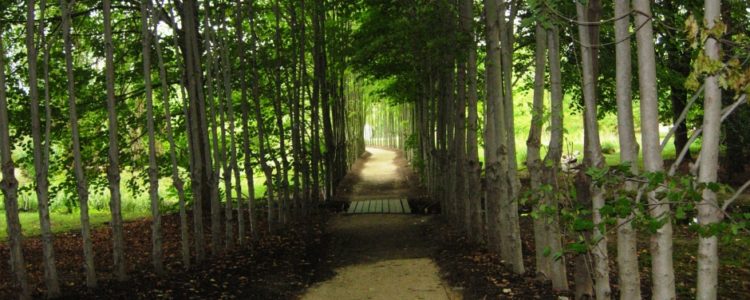At Grounds for Sculpture, a 35-acre sculpture park and arboretum in Hamilton, New Jersey, large contemporary sculptures line the entrance drive, and you think, “This place is all about the art, right?” Then you step out of your car, and along the walkway there are waves of turf with undulating metal edging, and you realize that this is also a very different kind of arboretum.
Here, plants are no less sculptural than the artworks they enhance. More than 25 species of ornamental grass and bamboo are used as hedges, accents, and herbaceous borders. Pennisetum ‘Karley Rose’, accented by its pink inflorescences in June and July, leads you along a curving path from the Visitor Center to access the park. Leymus, Panicum and Festuca look like a blue haze planted around a pond filled with lotuses. A bamboo grove becomes part of the sculpture Erotica Tropicallis. Go through the bamboo, past skulking voyeurs, to enjoy Seward Johnson’s metal and Styrofoam rendition of Henri Rousseau’s painting The Dream.
It is hard to believe that as recently as 1989, this lush garden was the old dilapidated New Jersey State Fair Grounds. Then it was a flat vacant wasteland with part of an old race track, abandoned exhibition buildings, and “crummy soil,” according to Brian Carey of AC/BC Associates, landscape designer for the park. In less than two decades, the original 17 acres and 12 trees have grown to 35 acres and more than 3,000 trees and shrubs. With the excavation of berms, ponds, and watercourses, the designers sculpted the flat land into a charming contoured setting that obscures the industrial surroundings and becomes a backdrop for sculpture.
The transformation happened in part thanks to tree donations and to Carey’s ability to rescue large specimens from construction sites and abandoned nurseries. Six lacebark pines (Pinus bungeana) were saved from destruction with only a few days’ notice. These three-needled pines with mottled exfoliating bark are some of the finest examples of the species anywhere. Hundreds of red maples, grown inches apart, were transplanted from the defunct Princeton Nurseries. Carey explains how the trees were “dug in blocks of eight, like sausages,” then spliced back together to create a narrow allée, creating a tunnel of color in the fall. “The best part is that so far, only one tree has died,” he says.
When it comes to handouts, Carey says he will “take anything with interesting or exfoliating bark,” including thorns. An area unofficially known as the “pain garden” contains thorned honey locust, castor-aralia (Kalopanax pictus), pyracantha, and trifoliate orange (Poncirus trifoliata). Throughout the park, look for trees with ornamental bark, such as stewartia, river birch, parrotia, and paperbark maple.
Conifers abound with 15 species of pines, as well as deciduous conifers that offer a splendid palette of spring and fall color. In front of the museum building stands a 50-year-old hinoki false cypress donated by nurseryman Tom Dilatush. Rare fastigiate conifers from Nancy Vermeulen dot the landscape. Not to be missed is a towering golden oriental spruce (Picea orientalis ‘Aurea Compacta’). Portals of weeping pines and spruces guide you from a wisteria-covered arbor to the Visitor Center.
Do not overlook the water garden. Here Carey shows “water used in as many ways as possible,” including fog that circulates around sculptures and around the sculpture-like leaves of coltsfoot (Petasites japonicas). A Camperdown elm (Ulmus glabra) serves as an umbrella to keep you dry. Nearby, take a walk through the Domestic Arts Building, pass through its indoor exhibits, café, and bookshop and go out to the Acer Courtyard, home of 47 rescued Japanese maples. Then relax, have a seat at one of the courtyard tables, and take in the view.
Grounds for Sculpture is located at 18 Fairgrounds Road, Hamilton, NJ, 609-586-0616 (groundsforsculpture.org).
